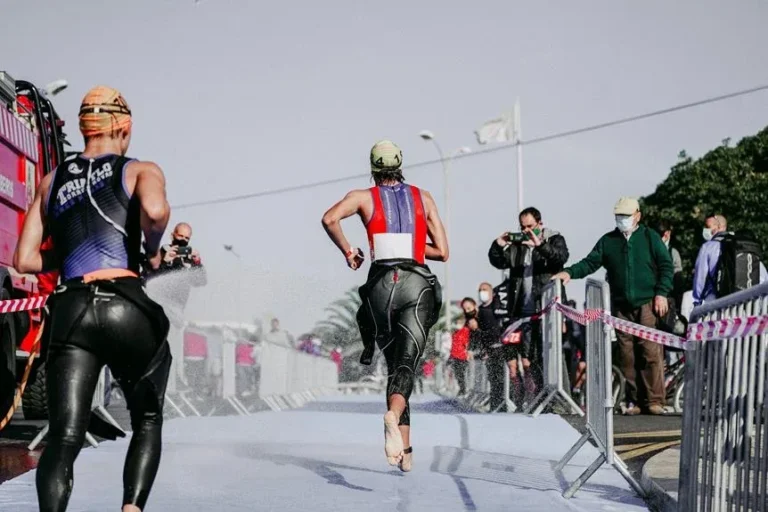Have you ever wondered how to determine the ideal race length for your first triathlon? It’s not just about picking any race; it’s about selecting the one that aligns best with your abilities and goals.
Understanding the nuances between sprint, Olympic, half Ironman, and full Ironman distances can significantly impact your overall experience and performance. By carefully evaluating your strengths and aspirations, you can set yourself up for a successful triathlon debut.
So, how do you ensure you’re making the right choice for your inaugural race?
Key Takeaways
- Consider fitness, strengths, and training time when selecting race length.
- Sprint triathlons offer beginner-friendly, flat, and fast options.
- Transition from sprint to Olympic requires specific training plans.
- Half Ironman demands endurance, consistency, and mental preparation.
Factors to Consider When Choosing Race Length
When selecting the perfect triathlon race length, it’s crucial to consider a variety of factors that will impact your performance and overall experience.
As a first-time triathlete, choosing the right race length can significantly influence your training and race day outcome. Evaluate your fitness levels and the time you can dedicate to training. Assess your strengths in swimming, biking, and running to determine which race distances align best with your abilities. Strength training can also play a vital role in preparing for the demands of a triathlon.
Consider the time commitment required for training for different race lengths; longer races may necessitate more extensive preparation. Seek guidance from experienced triathletes or coaches to ensure you select a race length that suits your goals and capabilities for your first race.
Sprint Distance Triathlon
Embark on the exhilarating journey of a Sprint Distance Triathlon, a perfect starting point for beginners or those seeking a swift and challenging race experience. If you’re considering this shorter distance race, here are some reasons to take the plunge:
- Efficient Transitions: Sprint triathlons provide an excellent opportunity to learn and perfect your transitions (T1 and T2), a crucial skill in triathlon racing.
- Beginner-Friendly: Designed with beginners in mind, the sprint distance allows individuals with limited training time to participate and enjoy the race.
- Pool Swim Options: For those new to open water swimming, many sprint triathlons offer pool swim options, easing beginners into the experience.
- Fast Routes: Sprint triathlons typically feature flatter and faster routes compared to longer distances, perfect for those looking to push their limits in a shorter time frame.
- 750m Swim, 20km Bike, 5km Run: With a 750m swim, 20km bike ride, and 5km run, the sprint distance offers a challenging yet achievable goal for aspiring triathletes.
Olympic Distance Triathlon
Transitioning from the sprint distance to an Olympic distance triathlon marks a significant step up in both challenge and distance for triathletes looking to push their limits further. An Olympic distance triathlon typically includes a 1.5km swim, 40km bike ride, and 10km run. This race distance demands more specific training plans, especially for open water swimming, as opposed to the controlled environment of a swimming pool.
Additionally, you might encounter hilly and technical bike routes during the cycling leg, which require preparation. Beginners may need to commit 6-10 hours per week to training, while advanced athletes could be looking at 10-15 hours. To excel in Olympic distance races, it’s crucial to match your training to the race course conditions. These longer distances will challenge your endurance and speed capacities, setting you up for a fulfilling triathlon journey.
Get ready to embrace the extra mileage and elevate your triathlon training with a focus on Swim Training.
Half Ironman (70.3) Triathlon
Considering a Half Ironman (70.3) Triathlon? This distance, consisting of a 1.9km swim, 90km bike ride, and a 21.1km run, is a challenging but achievable goal for many triathletes.
To prepare for a Half Ironman, you’ll need to focus on training that enhances your endurance, builds strength, and strengthens your mental preparedness. Completing a Half Ironman typically takes athletes between 5 to 7.5 hours, depending on various factors.
Here are five things to keep in mind as you consider taking on this challenging race distance:
- Training for a Half Ironman requires dedication and consistency but can be incredibly rewarding.
- The Half Ironman distance is a great way to push your limits and see what you’re capable of.
- Building up your endurance and strength gradually is key to success in a Half Ironman.
- Mental preparedness is just as important as physical training when it comes to completing a Half Ironman.
- Crossing the finish line of a Half Ironman can be a life-changing experience and a significant accomplishment in your triathlon journey.
Full Ironman Distance Triathlon
Preparing for a Full Ironman Distance Triathlon demands unwavering dedication, mental resilience, and rigorous training over an extended period. This IRONMAN distance race isn’t for the faint of heart; it includes a 3.8km swim, 180km bike ride, and a 42.2km run, making it one of the most challenging triathlon distances available.
Endurance athletes who take on this challenge must commit to months of training to build the necessary stamina and mental toughness required to finish the race. The full ironman distance triathlon can take anywhere from 8 to 17 hours to complete, depending on individual fitness levels. It’s crucial to adhere to strict cutoff times during each segment of the race to avoid disqualification.
For those aiming to Qualify for Kona, the prestigious IRONMAN World Championship, participating and excelling in a Full Ironman is important to consider.
Conclusion
Congratulations on taking the first step towards becoming a triathlete! Remember, selecting the perfect race length is key to a successful and enjoyable experience. Consider your athletic background, fitness level, and time commitment when choosing a race.
Start with a sprint-distance race to ease into the sport and set realistic goals for your triathlon journey. With the right preparation and mindset, you’ll be crossing that finish line with pride and accomplishment in no time.
Good luck on your triathlon adventure!
